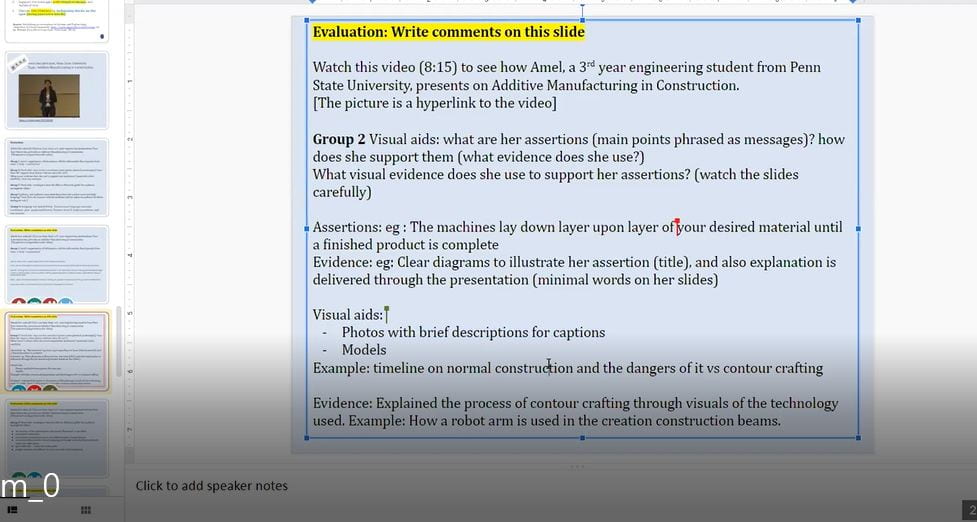Misty COOK
Centre for English Language Communication (CELC)
Misty discusses the activities she incorporated into her synchronous online lesson to ensure that students are actively engaged with their instructor and peers throughout the virtual session.

Student engagement is critical in promoting student learning in a synchronous online lesson (Banna, Lin, Stewart, & Fialkowski, 2015). This means a student-centred lesson requires striking a good balance between instructor-to-student and student-to-student interactions in the (co)construction of knowledge/skills during the lesson (Martin & Bolliger, 2018).
To maintain engagement with my students, I share what could be done before and during a 90-minute synchronous online lesson.
Give students clear instructions and expectations of the lesson
In the past, I emailed or posted the class materials on LuminNUS prior the lessons so students could prepare. However, in an attempt to reduce teacher talk, I also informed students on the following:
- lesson etiquette (e.g. log into the lessons using their names, and mic/camera use)
- class discussion topics/questions
- group activities and breakout room arrangements on Zoom
- links to other platforms
Balance between instructor-to-student and student-to-student interactions in bite-sized chunks
Including breaks during a 90-minute face-to-face lesson was not common. However, to prevent Zoom fatigue and cognitive overload among students, I segmented my online lessons into bite‐sized chunks (Clark & Mayer, 2016), with a recommended 5- to 10-minute break after 60 minutes (McNeill, 2014). Each segment would correspond to a lesson purpose.
Here is how I arranged an online oral presentation with 24 Computer Engineering students (see infographic):

 Reinforce key learning objectives and learning points in instructor-to-student interactions
Reinforce key learning objectives and learning points in instructor-to-student interactions
Students discussed effective ways to present technical information using PowerPoint slides (PPTs) and conduct a live demonstration to a technical audience. In a live classroom, it was possible to gauge the depth of students’ understanding from their verbal and non-verbal responses to further engage them in class discussions.
However, for synchronous online discussions, I found that students require more time to think and type the answers. Keeping this in mind, I consciously allocated time for responses to be contributed in our Zoom’s chat box before encouraging my students to verbally share answers. This was followed by positive and constructive feedback to encourage further discussions as we continued the session.

 ‘Humanise’ online learning environment in student-to-student
‘Humanise’ online learning environment in student-to-student
Groups of 4-6 students were required to apply taught skills by evaluating a technical oral presentation based on the key learning points (see Figure 1), then discuss and type the answers on the shared PPTs in the breakout rooms.
My job as a facilitator was to go into the breakout rooms to check students’ progress, ensure they had a ‘voice’ in sharing their thoughts while interacting with each other and the instructor in small groups. This is a crucial way to ‘humanise’ an online learning environment (Ho, 2020).

With guidance, students completed their tasks to a high standard as they were able to capture the key taught skills (Figure 2).


 Create opportunities for students to respond and value-add in instructor-to-student interaction.
Create opportunities for students to respond and value-add in instructor-to-student interaction.
All students from each group shared their group evaluations. The other students and I responded and value-added to existing points to reinforce taught skills (Figure 3).

 Value-add to student learning in instructor-to-student interaction
Value-add to student learning in instructor-to-student interaction
As the need for online presentations increases, we also talked about the similarities and differences between delivering technical information face-to-face and online. Time was given to students to raise questions/concerns about the format of the online presentations (Figure 4).

 Clarify instructions for next lesson
Clarify instructions for next lesson
The lesson ended with instructions on tasks to be completed before the next lesson, and the next lesson’s arrangements (Figure 5).

As with all face-to-face teaching settings, instructors conducting online lessons should support student learning inside and outside the virtual classroom. Instructors can support students by providing clear instructions and sharing materials before lessons so that students could prepare. Furthermore, with the possibility that students may feel isolated in an online learning environment, it is important for instructors to engage students by scaffolding course materials through student-instructor and student-student interactions during the online lessons.
 |
Misty So-Sum WAI-COOK is a Senior Lecturer at the Centre for English Language Communication (CELC) and Fellow at the College of Alice & Peter Tan (CAPT). Misty has extensive experience in teaching oral and written communication skills in tertiary education. She is a strong advocate in providing feedback to further promote student learning, and leveraging on technology to enhance students’ learning experience. Misty can be reached at elcmsw@nus.edu.sg. |
References
Banna, J., Lin, M. F. G., Stewart, M., & Fialkowski, M. K. (2015). Interaction matters: Strategies to promote engaged learning in an online introductory nutrition course. Journal of Online Learning and Teaching / MERLOT, 11(2), 249-261. Retrieved from https://www.ncbi.nlm.nih.gov/pmc/articles/PMC4948751/.
Clark, R., & Mayer, R. (2016). Applying the segmenting and pre-training principles: managing complexity by breaking a lesson into parts. E-Learning and the Science of Instruction: Proven Guidelines for Consumers and Designers of Multimedia. John Wiley & Sons.
Ho, S.S.M. (11 April 2020). Real-time video teaching can improve classroom teaching. University World News: The Global Window of Higher Education. Retrieved from https://www.universityworldnews.com/post.php?story=20200410135834115.
Martin, F., & Bolliger, D. U. (2018). Engagement matters: Student perceptions on the importance of engagement strategies in the online learning environment. Online Learning, 22(1), 205-222. http://dx.doi.org/10.24059/olj.v22i1.1092
McNeill, B. (2014). Time and the working online learner. In Assessment and Evaluation of Time Factors in Online Teaching and Learning (pp. 24-62). IGI Global.

